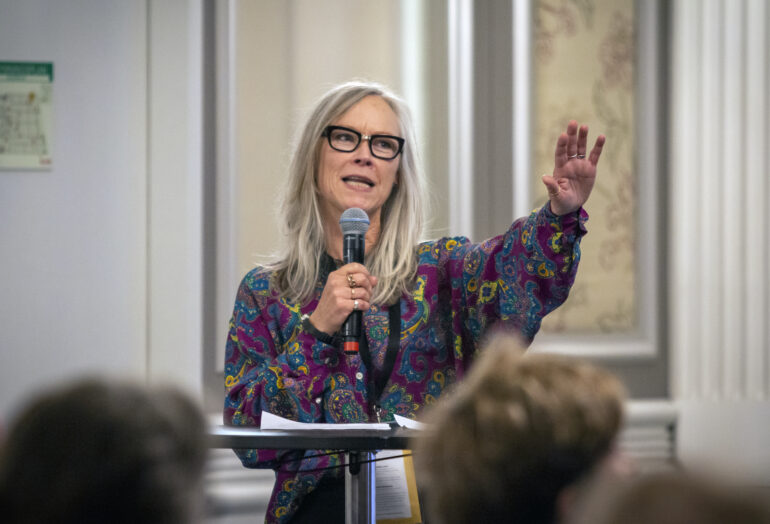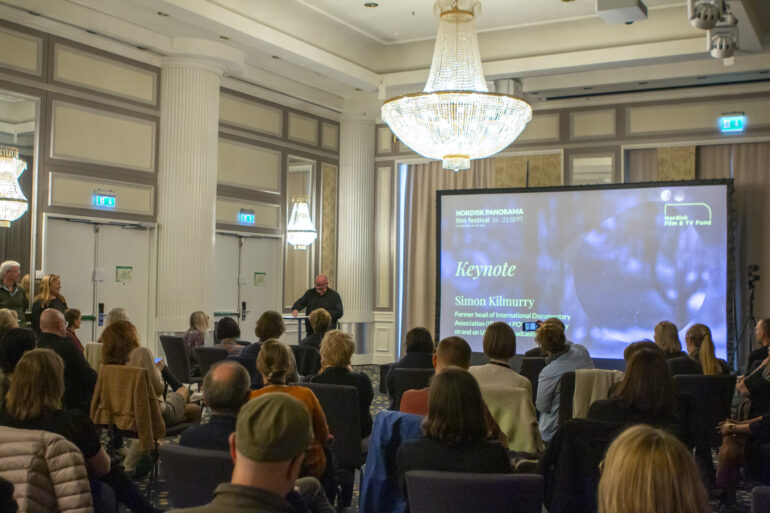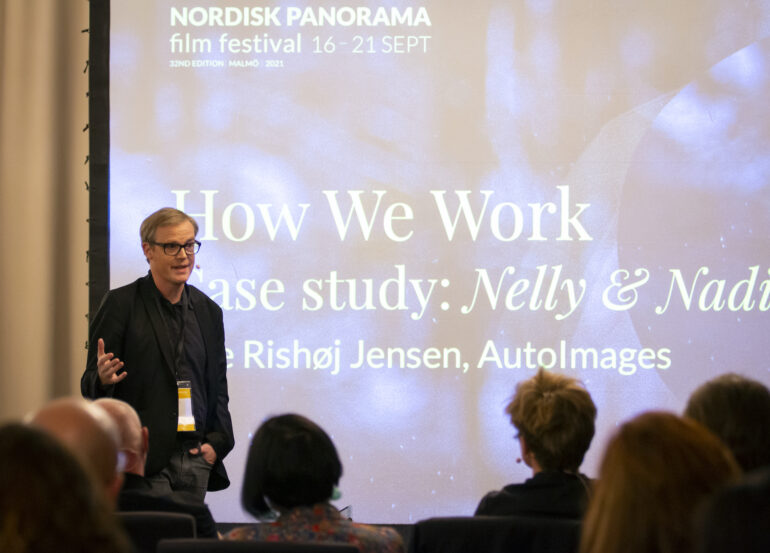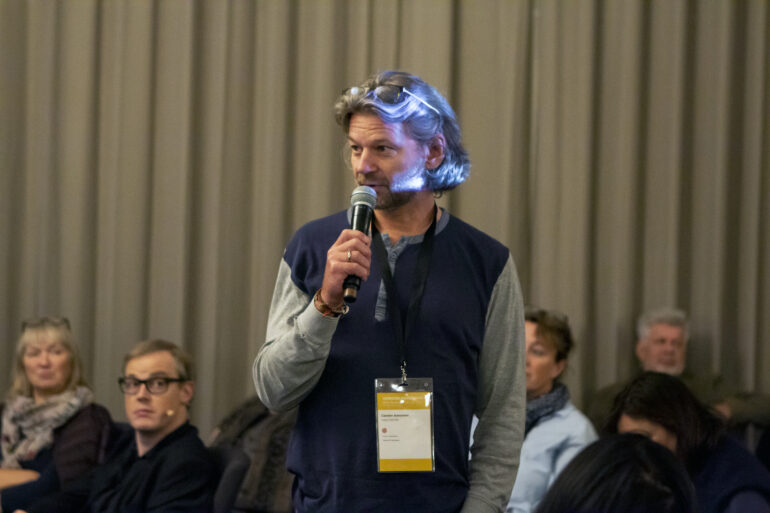WRITTEN BY: Nick Cunningham
The Town Hall professional forum returned to Nordisk Panorama September 19, its stated aim to work out how best to overcome obstacles and embrace opportunities within the ever-changing documentary landscape. The event was presented in collaboration with the Nordisk Film & TV Fond.
Chaired by Nordisk Film & TV Fond’s Senior Advisor Documentary Karolina Lidin, the Town Hall saw producers, funders, broadcasters and leading doc talent gather once more to grapple with the major issues affecting the documentary community, to share both knowledge and opinions, seek collaboration opportunities and to get fired up about the industry we all love.
The establishing ethos of the Town Hall session is that the floor is open to contributions from everybody, with each contribution bearing exactly the same weight.
The agenda was set with three top-level presentations during the event’s 90-minute duration. It opened with a keynote by Simon Kilmurry, former head of both IDA and the POV (US public broadcasting documentary strand).
This was followed by two case studies, the first by producer Ove Rishøj Jensen (AutoImages) on the financing of Swedish director Magnus Gertten’s Nelly & Nadine, about two women who fell in love on Christmas Eve 1944 in the Ravensbrück concentration camp.
In the second case study, Miia Haavisto from Tekele Productions discussed the distribution strategy around the launch of the Finnish feature doc Lost Boys, by Joonas Neuvonen and Sadri Cetinkaya.
Simon Kilmurry keynote
In his keynote address, Simon explored the myth that we are living in a “Golden Age” of doc. Rather it is a “Corporate Age,” he argued.
“The documentary world is shifting from one that had a social and creative and democratic function at its core to one that's market-based. And that I think threatens the future of the field,” he said. The recent boom in doc is “driven by the bottom line,” he said, “and privileges genres such as true crime and celebrity focussed films, and also privileges those filmmakers who have the longest track records.”
These imbalances, he argued, could well lead to the homogenisation of filmmaking language, and further marginalize filmmakers who do not have access to those with power and resources, and hence may drive them away altogether. “Any field that adheres too closely to a purely capitalist system will eventually only support those films can reach the broadest possible audience and cater to the lowest common denominator.”
He cited results of a recent IDA survey (albeit US-oriented, but indicative of experience everywhere, he argued) showing that 75% of filmmakers are forced to work outside of filmmaking just to make a living. 74% of filmmakers reported that they have been negatively impacted by the pandemic, and of that group “filmmakers of colour and female filmmakers were the most economically disadvantaged in terms of film income, revenue, and access to the bigger money that streaming networks can offer.”
But he sees hope, he underlined, in the collective will to force change and to build a stronger and more equitable eco-system. The “loosely formed” coalition of marginalised filmmaker bodies that gathered at the 2018 IDA Getting Real conference (represented by the likes of Brown Girls Doc Mafia and Filmmakers With Disabilities) had evolved into a vital and undeniable movement that made sure their demands were promoted “from the margins to the centre.”
“The coalitions of filmmakers had evolved into groups that are now beginning to exert some measure of power and influence not only on commercial outlets, but on our public broadcasters and our funders - pushing for transparency, pushing for accountability.” To which the likes of PBS are actively and positively responding in terms of allocation of “new” resources, he said.
He also addressed the “thorny question” of authorship and diversity in the doc field, and argued that proper soul-searching makes for greater creative and business opportunities, as opposed to creating obstacles. “Why am I the right person to tell this story?” he asked rhetorically to a primarily white audience. “What impact will this story have in this community when I leave, what are my motivations and connections to this community? Do I have people on my team whose experience, perspective, background is different from mine that will challenge me? I think if you can answer these [questions] honestly. If you can answer ‘yes’, then you'll end up with a richer and more complex, nuanced, honest, artful film.”
Case Study 1: Nelly and Nadine - Ove Rishøj Jensen (AutoImages)
Ove explained how Nelly and Nadine is a co-production between Sweden, Norway and Belgium with a production base in France where key protagonist Sylvie, the grandchild of the titular Nelly, lives.
“But as I think many of us has experienced, what was kind of a co-production creative blessing very quickly became a cross-border burden,” he commented. “We had shot around 80% of the film when the whole pandemic hit. What do you do then? How do you continue? How do you keep up the contact with your main character, these kinds of very practical problems that I think a lot of you probably have experienced as well during this pandemic, but also more production aspects.” Such as maintain production spend commitments when everybody is effectively grounded, he added.
Ove spoke of the troublesome Covid-19 ghost whom he expects to be a “guest at the [production] table” for years to come, and the Zoom fatigue that we all have experienced during the pandemic as well as the difficulties of replicating pitching structures online. “We lost this kind of informal exchange of understanding and market knowledge, and really understanding what are actually now the new expectations from broadcasters, from funders,” he added.
But was the experience on producing Nelly and Nadine a bad one? “Absolutely not,” Ove said. “And I hope that some of you recognize that [there] has also been something very liberating and nice about the last year and a half. At least I've never spent so much time with my family…And I think as producers we've been used to this kind of traveling circus where you have to travel around and pitch your project four or five times to get it financed…And I must say, I felt for the last year a certain relief, that actually all of a sudden it was possible to cut away a little bit all the noise, and have much more focus on the actual work actually producing and doing the film.”
Klara Grunning, who helped finance Nelly & Nadine as Film Consultant Documentary at the Swedish Film Institute (before she left for the Norwegian Film Institute) commented of her evolving modus operandi during Covid: “One of the good things has been not only to be able to focus on the actual work, but also the connection and access to those dialogues and those discussions that you have with the stakeholders,” she said, referencing the greater sense of “democracy” she has witnessed. “It has also been easier for those who haven't been to markets and that live far away from those places to get the same access. So I have, in my position, had connections with a lot of new people, which I think is very exciting, because that's exactly what we're aiming to work on going forward…Looking at new perspectives and voices is the blood that we need into the market in order to continue.”
The Swedish Film Institute’s Co-ordinator of Documentary Jenny Örnbom explained that Nelly and Nadine had benefited from Fund support for costs that arose as a result of the pandemic. She also stressed how the Institute offers “continuity” support once a year, “to keep our production companies healthy” and that two additional rounds of such support were offered to approximately 80 companies, “so they can continue to do development.”
Axel Arnö, Commissioning Editor at SVT, noted an existential shift within the public broadcasters, and especially the commissioning editors, from “kings of the universe” to folks now pitching for the content. “Of course we are now not a broadcaster anymore, we are sort of a small local platform with two linear channels,” he said.
That said, he spoke of advance plans in building a pan-Nordic group of commissioning editors. “We know each other and we try to pool our resources and we want to speak to you [addressing documentary content providers] not when you have your program already, but before. So talk to us about what you want to do… In return for us becoming more open and better in all ways, hopefully, we will also need you to understand our world. We need to be relevant. We need to have the eyes of the audience,” he said.
“But I'm also working in the EBU surroundings and, and the EBU documentary group has the same problem. So we are now trying to build a bigger coalition. So in two weeks there'll be a conference, a workshop where we are coming together to build a new way, a new model of co-financing of films and to do it as a fast track. So it will be faster to development money and faster to production money.”
Case Study 2: Lost Boys - Miia Haavisto, Tekele Productions
“It was a surprise hit against all the odds,” Miia said of the ground-breaking and controversial film, directed by Joonas Neuvonen and Sadri Cetinkaya. “I worked for eight years on this film, and the filmmakers [worked] even longer, for 10 years. So I wasn't quite sure whether the film would ever be completed, but it was.”
Lost Boys sold 73,000 tickets in Finnish cinemas, “which was big, especially in COVID times. We had to stop the run in distribution because the theatres closed down, but we were very happy with the end result…So seeing a film like this performing so well in theatres was a huge surprise to everyone.” It was the fourth highest-grossing doc ever at the Finnish box-office, she underlined. Released by SF Studios, it generated €300,000. “We had a campaign like for any fiction feature…a campaign lasting around three months,” said Miia.
The film was a follow-up (of sorts) to the notorious Reindeer Spotting – Escape from Santaland, featuring some of the same characters, which was released in 2011 and which itself drew 63,000 admissions.
Miia put in place a “limited” press strategy, not giving out any information about the film until she released the trailer. In addition, she put a hold on interview access until very close to the September 15 premiere. Press interest was further piqued by co-director Joonas Neuvonen going AWOL for a while, therefore cranking up the sense of anticipation among journalists.
She had a “reasonable” marketing budget of €60,000 at her disposal, which she likened to the spend on a fiction arthouse film. What’s more, the film’s X-rated content was used to promote it, especially to the primary audience of 18+ and then to secondary audience of 30+ who would have been acquainted with Reindeer Spotting, release almost a decade before.
“The launch in theatres worked very well for VOD,” she added, noting that she had an approximate ten-week window to maximise revenues before the film aired with broadcaster YLE. “The thing is that because it's X-rated content, we could only have it in electronic sell-through and on TVOD platform, not on SVOD as people needed to subscribe…but the film sold 7,000 times on EST (electronic sell-through) for around 15 euros. And then it was rented out 27,000 times for around five-year euros. So in total, the revenue was substantial.”
Interestingly, Miia never referred to the film as a documentary during her marketing campaign. “I'm a cinema lover. I have a background as a documentary director, but I would still avoid the word,” she underlined.
Norwegian producer Carsten Aanonsen spoke about the TikTok marketing campaign for his similarly-themed film Young & Afraid, which is (like Lost Boys) in Doc Competition at Nordisk Panorama. “I've never had TikTok myself so I had no idea what kind of impact it could have. But 400,000 people saw that first sequence [in August],” he said, a number which has subsequently grown to over 700,000, he confirmed. Young & Afraid goes into Norwegian cinemas on September 24.
Towards the end of the debate, independent producer Gitte Hansen praised Lost Boys, likening it to Uli Edel’s seminal Christiane F (1981). She also made a plea to the public broadcasters in the room. “Please, please, please think not only of what the audience wants to see, whoever decides that. Think about the filmmakers out there, they are the ones with the stories. They are the ones with the talent to create something. Look at that and follow that line as a public service institution.”
Miia Haavisto offered an interesting piece of additional advice to docmakers - to stick to docmaking. “I think the creatives are doing a lot connected to packaging films. They are doing a lot connected to marketing the films. They are making the posters, they are making the trailers,” she said. “But I strongly think that it's up to the producer and the distributor to do all the marketing materials and to improve the film so that the audience will actually find it. So I will say this early on to all directors I work with, that you focus on directing your masterpiece and we'll work on getting it to the audience.”
At the end of the day, the desire for collaboration was evident, as expressed by Norwegian producer Carsten. In so doing, he underlined the importance of the national Nordic institutes and the core role they must play in supporting the co-production of doc content. But he expressed a note of caution. “Because it’s not enough,” he said. “We need to bring it up more essentially in each of the film institutes in the Nordics, to make them actually put even more money into the co-productions, between the Scandinavian production companies.”
“We see in the NFI (Norwegian Film Institute) that they are so commercially organized these days,” he continued. “They say ‘bring in more money from international distribution, because every Norwegian kroner is worth more’. It’s like - yeah sure - but we have a very great symbiosis in the Nordic countries, and we need to take care of that. We cannot reduce the co-production money from the film institutes. This is very, very important.”
Watch the recorded session here:



